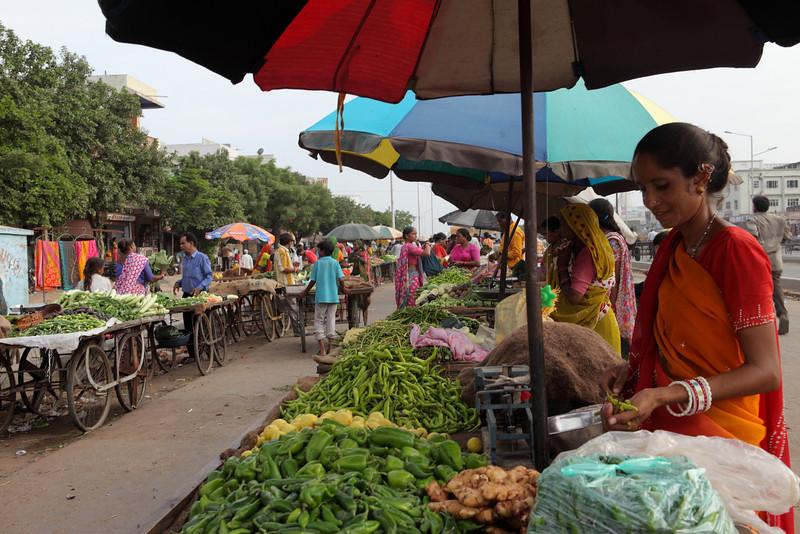‘Atma Nirbhar’ Street Vendors: A Far-off Dream, Say Activists

Representational image. | Image Courtesy: lawnn
It is said, better late than never. Some activists and academics, hesitantly, thought the old maxim could be applied to the Centre's micro-credit facility for street vendors – which was indisputably behindhand, in the wake of the coronavirus-triggered lockdown, announced on March 24.
But, more than a month down the line since its launch, the programme is not proving to be any beneficial either.
The majority of the eligible vendors are not able to avail the Rs. 10,000 loan, under the Pradhan Mantri Street Vendor’s Atmanirbhar Nidhi (PM SVANidhi), their representative bodies’ have alleged, owing to an array of challenges.
These include: barriers – both, digital and language – in applying for the loans and inadequate documentation, available with vendors. Applications for the loan have to be submitted online, which further involves entering a phone number-linked Aadhaar card details.
“By making the whole process online, the vendor's capability of self-applying has been limited. This has resulted in them approaching the local cyber cafes, which are charging exorbitant amounts to do the same,” said Dharmendra Kumar of the New Delhi chapter of Hawkers’ Joint Action Committee. The body is engaged in assisting the street vendors in applying for the loan.
“Also, for many vendors, either the Aadhaar card is not linked with their phone number or their contact details [linked with the Aadhaar] have changed over the years,” he said.
It seems that the socio-economic background of the street vendors – who are predominantly migrants and relatively less educated – was not thought about before launching a scheme for them, Kumar said, adding that forms are available only in the English language, which compounds the hurdles.
The concerns don't end here. Kicked off on June 1, PM SVANidhi targets about 50 lakh street vendors across the country for relief against the economic jeopardy caused by the lockdown.
Activists flay the poor coverage, which hardly covers the country’s vending population, that is almost 4% of the urban workforce, touching close to four crore, across the country.
“The test of the pudding is in the eating. Initiating a scheme for street vendors is not enough when a majority of them are set to get excluded, anyway,” said Shalini Sinha, India Country Representative for Women in Informal Employment: Globalising and Organizing (WIEGO), a global research policy network focusing on women workers in the informal economy.
“Tying up a relief measure with documents and identification processes runs counterproductive to the objective of the very scheme for street vendors. This is so, as the registration of the vendors has been an issue for many years now. For that, there is a powerful law in spirit, but its implementation is weak.”
Sinha is referring to Street Vendors Act of 2014, which mandated registrations in the city, of the vendors, hawkers, and peddlers, through surveys conducted by Town Vending Committees.
However, as Kumar pointed out in one of his pieces in Countercurrents.org, the process is yet to see the day of light in almost all the states, with Madhya Pradesh, Karnataka, Maharashtra, and Uttarakhand are yet to even notify schemes under the act. Some states are yet to identify any vendors, while in other states, heavy under-identification can be witnessed during the surveys conducted.
Also read: COVID-19: Amid Surging Fresh Cases in Bihar, Recovery Rate Declines
Fully aware of this, the Centre, in its attempt to identify beneficiaries for the scheme, has directed the urban local bodies (ULBs) to issue a letter of recommendation (LoR) to those who are left out of the surveys, making them eligible for the loan. According to the scheme guidelines, the issuance of the LoR must be completed within 15 days of the submission of the application.
Shakeel Ahmed, general secretary of CITU-backed Rehri-Patri Hawkers’ Union in Delhi, however, has a different tale to tell. It is much more difficult for the vendors to get a LoR from local bodies, he informed NewsClick.
Kumar explains this struggle: “On the [PM SVANidhi] web portal, there is no provision of uploading any document to support the claim of an individual – who is not covered under the survey – of him/her being a street vendor. If that is the case, then based on what do we expect the local bodies to issue recommendation letters – even when they are asked to be liberal in doing so.”
This, according to him, is the main reason why many of the applications also rejections. As on July 17, of the 1,54,000 street vendors who had applied for the relief across states and UTs, loans got sanctioned to only over 48,000, according to the Ministry of Housing & Urban Affairs (HUA), that is looking over the scheme’s implementation.
NewsClick tried to approach Durga Shanker Mishra, secretary, HUA; however, he was unavailable for comment.
The poor figures bring to the fore the issues that have been flagged by activists, believes Sinha. Further, “it will not be surprising if women constitute only a minority of those who avail the loans. It will be a big challenge to get them a loan – given that, in their case obtaining documents will be much more difficult,” she said.
This is despite women vendors being one of the worst-affected groups during the lockdown. A study of women vendors in Delhi had reported that 97.14% of the respondents recorded having been “adversely affected” by the lockdown.
Moreover, high chances are there that those who will eventually receive a loan – as working capital under the scheme – would actually divert it to meet other exigencies including food, house rent among others.
“Vendors have completely lost their livelihood, as a result of which, our organisations have recorded cases in which informal borrowers were approached – a large number of whom are very exploitative,” Kumar said.
Ultimately, even if the scheme gets well on the count, rehabilitation of even those street vendors would still be a far-off dream, he added.
In such a scenario, how many of the street vendors will actually become Atmanirbhar (self-reliant) can be left to one’s imagination.
Street Vendors Act, 2014 by Newsclick on Scribd
Also read: Coerced Exams During Pandemic Is Ludicrous
Get the latest reports & analysis with people's perspective on Protests, movements & deep analytical videos, discussions of the current affairs in your Telegram app. Subscribe to NewsClick's Telegram channel & get Real-Time updates on stories, as they get published on our website.
























